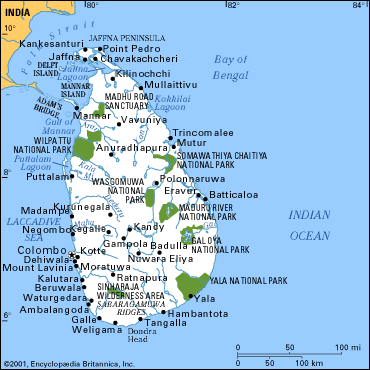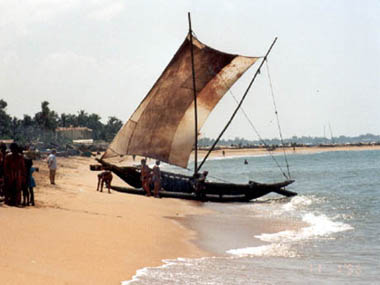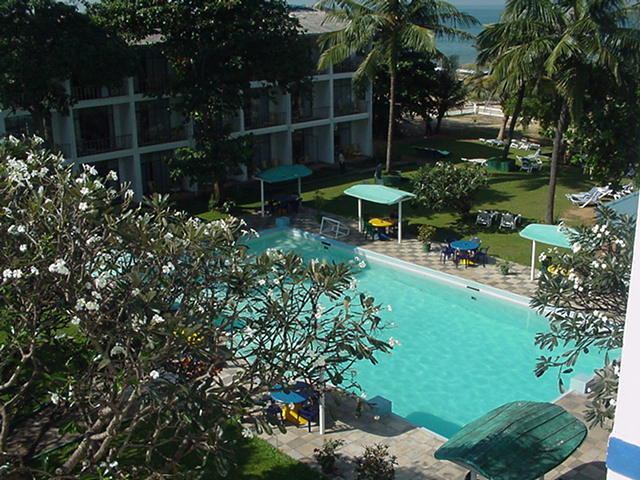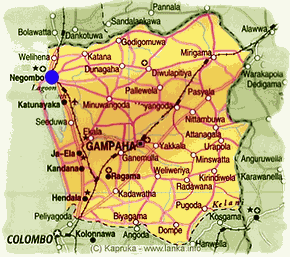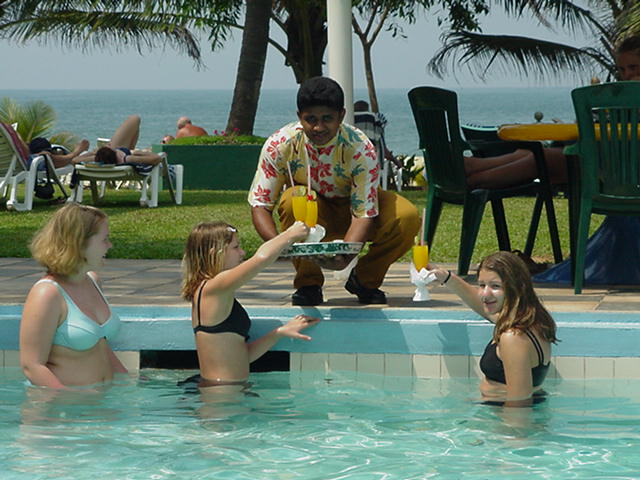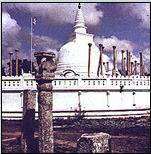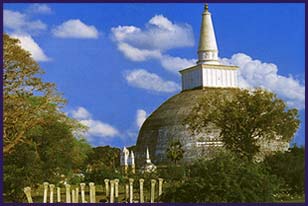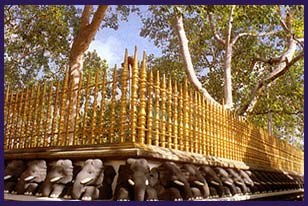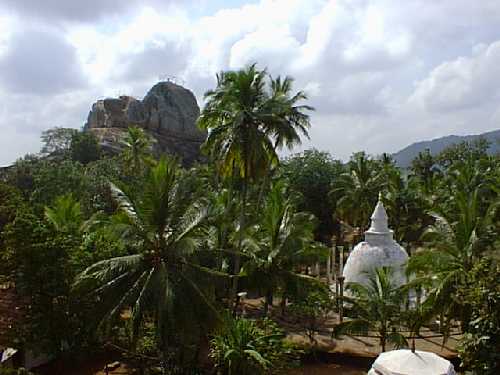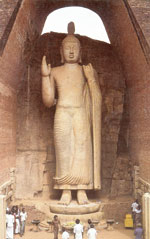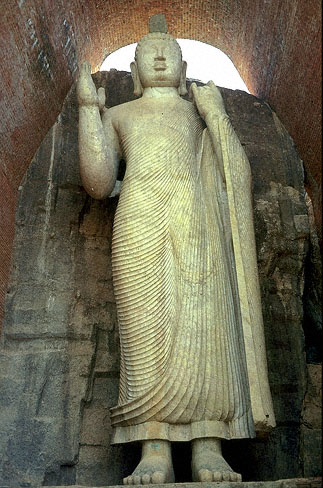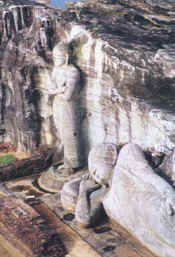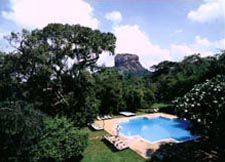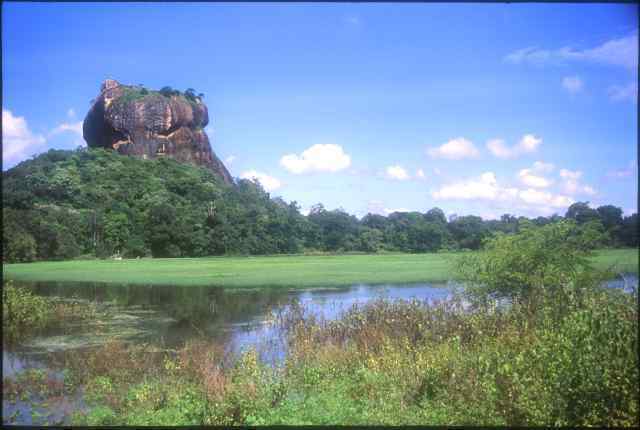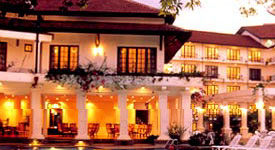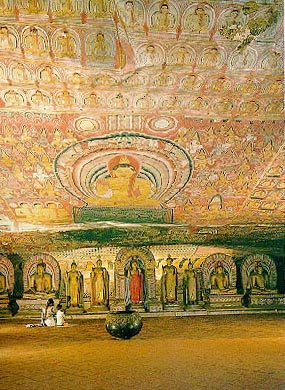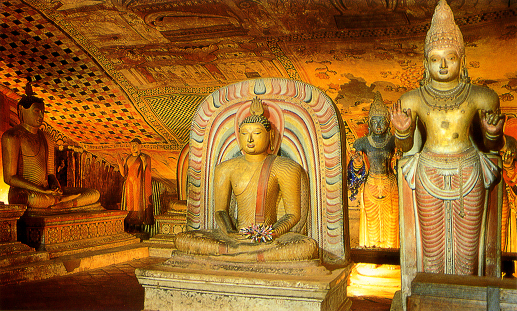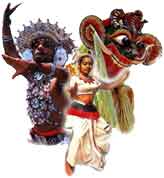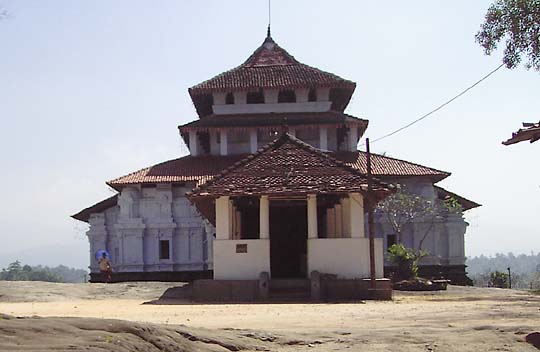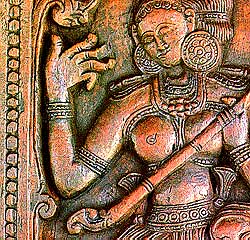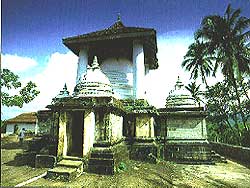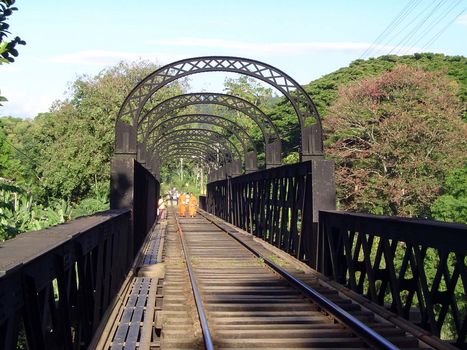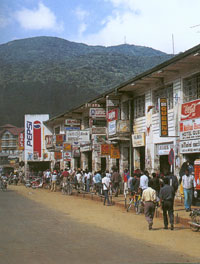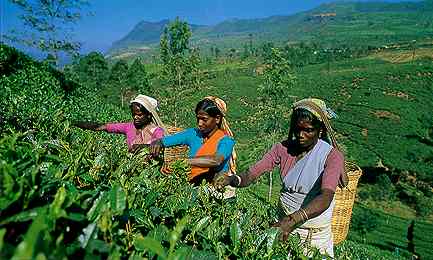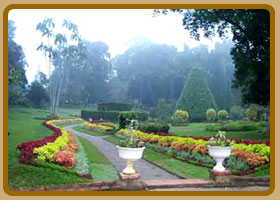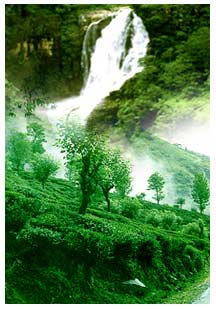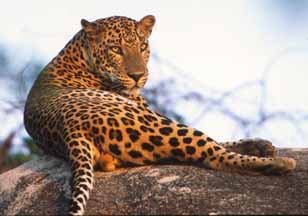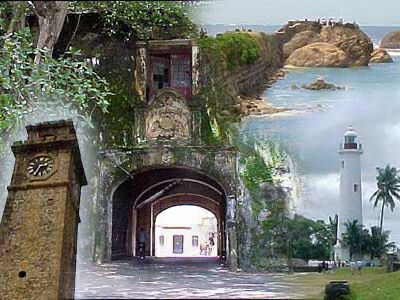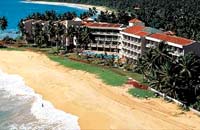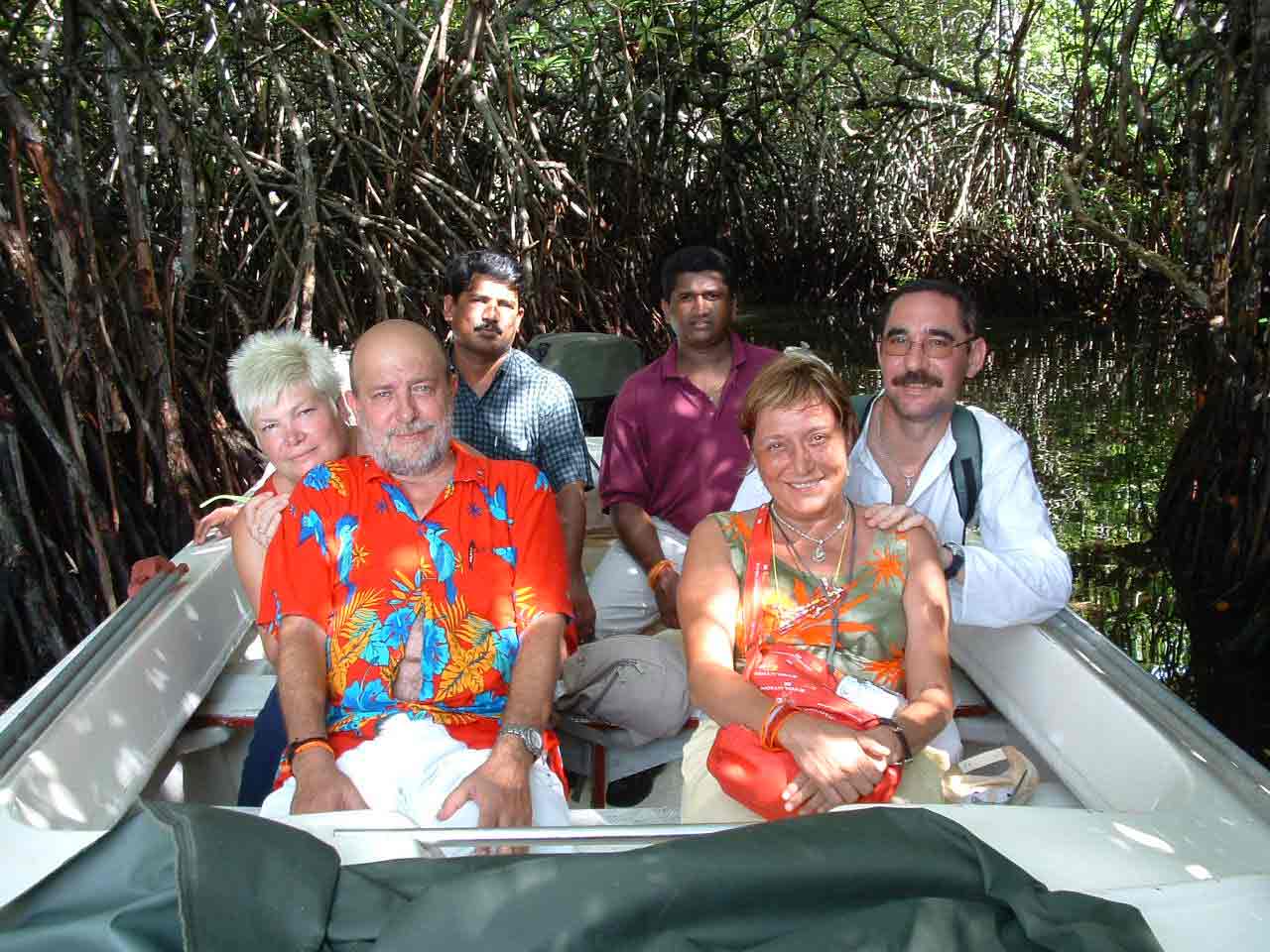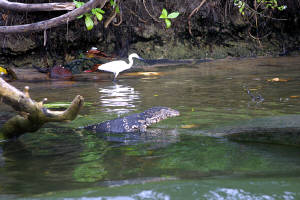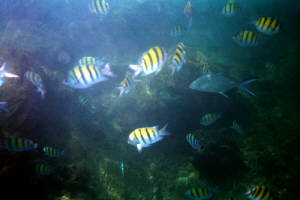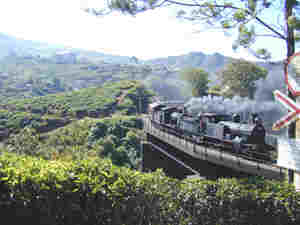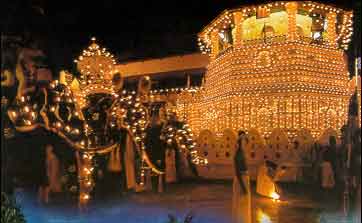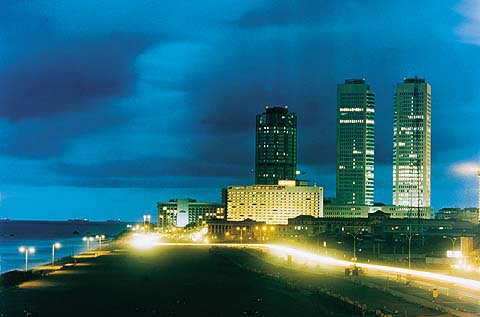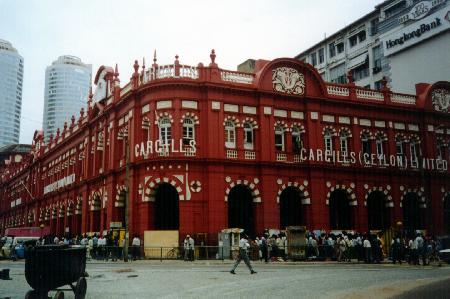VERANO CINGALÉS: DE LAS CIUDADES REALES A LAS TIERRAS ALTAS
Visitas: |
|
|
|
Royal cities and Highlands: With Galway Tours & Travels 23 Noches y 24 Días en Sri Lanka
|
|
Contact details: Miss Thanuja Siriwardhena, Junior Executive, Galway Tours & Travels, No 421, Rajagiriya Road, Rajagiriya. Sri Lanka. Phone: ++94-11-4714436, ++94-11-4716352, ++94-11-4616023, ++94-11-2887101, ++94-114-714436, Fax: ++94-114-616024 e-mail: thanuja@galway.lk Website: www.galwaytravel.com |
|
|
VUELO MADRID-LONDON-DOHA-COLOMBO |
DÍA 00 : Martes 26 de Julio de 2005 1.CORTESCANSINO/JOSEMARIA MR
2.SANCHEZ/DOLORES MS |
|
LLEGADA DE LOS CORTÉS AL AEROPUERTO INTERNACIONAL SIRIMAVO BANDARANAIKE EN KATUNAYAKE: TRASLADO A NEGOMBO (8 km) |
La desparramada ciudad de Negombo está a 8 Km del Aeropuerto y es un lugar maravilloso para empezar o terminar un viaje por Sri Lanka. Tiene una larguísima playa tropical que se extiende de forma interminable hacia el norte y acaba en el sur con el centro de la ciudad. Al sur una gran albufera (lagoon) con rica pesca y largos canales construidos por los holandeses, protegidos por un fuerte, también holandés. Antes que estos, los misioneros portugueses la llenaron de iglesias católicas y dejaron innumerables apellidos como Silva, Soysas, Mendises y Pereras. |
|
|
Los pobladores de Negombo fueron y son los Karavas, pescadores tamiles, que se convirtieron en masa al catolicismo durante el siglo XVII. Gracias tanto a la pesca marina como la de la albufera, Negombo es un importantísimo puerto pesquero y un maravilloso lugar de "papeo marisquil": atunes, tiburones, gambas, langostas, supercangrejos, etc, etc. Los KARAVAS son también famosos por sus muy especiales barcos de pesca, conocidos como ORUWAS, catamaranes muy peculiares. (La palabra catamarán deriva del idioma tamil: ketti-maran). Están formados por un tronco hueco unido a una enorme vela. Se pueden alquilar y navegar por el lagoon o el mar abierto. |
|
|
DÍA 01:Miércoles 27: Traslado de los Cortés al Camelot Beach Hotel de Negombo por seis noches. |
|
|
Negombo también es la ciudad de mayor vicio y perversión de la recatada Sri Lanka, "la marcha no cesa", los karaokes ensordecen, dicen que la cerveza corre y las chicas te siguen, pero no se ponga uvedé en topelés ¡la cagaste, burlancaster! A nivel de compras Negombo tiene de todo, pero su temporada alta es de Octubre a Abril. En la época monzónica, la contraria, muchas tiendas cierran. En cuanto a monumentos un par de horas con el fuerte iglesias y otras cosas por el downtown. Colombo la tenemos a 40 km hacia el sur a una hora de autobús y hora y media de pesado tren. En resumen: Playa tropical guay, misas, paseos en bici y en barcos, marcha, marisco y vicios varios. ¿Tendremos suficiente con seis días? |
|
NEGOMBO |
|
|
NEGOMBO |
DÍA 02: Jueves 28: stay at leisure DÍA 03: Viernes 29: stay at leisure DÍA 04: Sábado 30: stay at leisure DÍA 05: Domingo 31: stay at leisure (los Cortés) |
|
DÍA 05: Domingo 31: Salida Barcelonera cascabelera
1.CAPARROS/ENRIQUE MR 2.HERNANDEZ/ROSA MS |
|
|
LLEGADA DE LOS CAPARRÓS AL AEROPUERTO INTERNACIONAL SIRIMAVO BANDARANAIKE EN KATUNAYAKE: TRASLADO A NEGOMBO (8 km) |
|
|
NEGOMBO |
DIA 06 : Encuentro a las 8 de la mañana del lunes 1 de Agosto de los Caparrós con los Cortés en el Camelot Beach Hotel de Negombo por una noche. |
|
NEGOMBO-PINNAWELA-ANURADHAPURA(180 km) |
|
 |
DÍA 07: Martes 2 de Agosto: Después del desayuno nos dirigiremos al Galway Miridiya Lodge de Anuradhapura por tres noches, en ruta, visitaremos el Pinnawela Elephant Orphanage donde unos 60 elefantes huérfanos son alimentados y cuidados por las autoridades de la vida salvaje. Pinnawala Elephant Orphanage, a 90 km de Colombo, los ha mantenido en las manadas cautivas mayores del mundo. De acuerdo a los reportes también es el centro mas exitoso de alimentación de elefantes. El elephant orphanage fue creado en 1995 con siete huérfanos; hoy día tiene una población de sesenta y dos. El elephant orphanage ahora se jacta de su decimoséptimo nacimiento y de la segunda generación de nacimientos en cautividad. Con los adelantos actuales para estar realmente orgullosos tendrían que conseguir que algún mamutito siberiano naciera al lado de sus bebesitos actuales. A pesar de todo ha conseguido llegar a ser una de las mayores atracciones turísticas de Sri debido a su excepcionalidad. Es un lugar ideal para hacer fotos, investigar y aprender acerca de la educación de elefantes a medida que el visitante es capaz de observar las grandes manadas que comprenden desde pequeños babies de escasas semanas a viejos de más de sesenta años. |
|
ANURADHAPURA–MIHINTALE-ANURADHAPURA |
|
|
|
DÍA 08: Miércoles 3 de Agosto: Por la mañana visitaremos la resplandeciente ciudad de Anuradhapura (Patrimonio de la humanidad) donde podremos ver el blanco glamour de sus Stupas & Daghobas que son sus monumentos más prominentes. |
|
|
Visitaremos los templos Sirimabodi e Isurumuniya, también el sagrado Bo-tree, que es el arbol sagrado históricamente autentificado más antiguo del mundo: tiene más de 2250 años. El sagrado Bo-tree procede de un esqueje del Bo-tree bajo el que Buda alcanzó la Iluminación. También visitaremos el Monasterio y el Dagoba Abayagiri, los Estanque gemelos de Kuttam Pokuna y el Stupa Jetavana, que es el más alto stupa del mundo mundial. Al final de la tarde en estos sitios tienen lugar sus ceremonias rituales correspondientes. ¿Seremos testigos de ellas? |
|
|
Después de comer procederemos a visitar Mihintale, cuya significación espiritual para los cingaleses es enorme pues aquí se originó el budismo de Sri Lanka. La exploración de Mihintale requiere algunas dotes de alpinismo. Estas ruinas están datadas alrededor del año 247 antes de cristo. |
|
ANURADHAPURA –AUKANA- POLONNARUWA – ANURADHAPURA |
|
|
|
DÍA 09: Jueves 4 de Agosto: Por la mañana visitaremos la Estatua de Buda de Aukana. ¿Qué se podría decir de una de las maravillas del mundo? Es la larga estatua de pie de 12 metros de Buda de Aukana, otra de las maravillas arquitecturales de los antiguos cingaleses. Copias a gran escala se encuentran por todo el país , desde Dondra en el sur a Trincomalee en el norte. La estatua permanece de pie cerca del enorme embalse TANQUE DE KALAWEWA, fue "creada" por el desafortunado Rey Dathusena (459-477 dC). Originalmente se creyó que la estatua se esculpió en estos años, pero investigaciones posteriores la dataron trescientos o cuatrocientos años más tarde. Sin embargo nadie sabe exactamente cuando, como, para qué, por quién ni por qué fue esculpida. Las dataciones científicas indican que tienen el mismo tiempo que otras enormes estatuas de Sri Lanka, como las de la Gal Vihara y la Lankatilake de Polonnaruwa o las de Buduruwagala y Maligawila. Este breve "periodo loco" de mayestáticas estatuas coincide con la invasión desde la india de la influencia MAHAYANA, que enfatiza a Buda con algo sobrehumano y con potencialidades trascendentales. |
|
|
Aukana significa "comer sol" o "alborada", cuando aparecen las primeras luces del alba se pueden ver los finísimos detalles de la estatua, que encara a los primeros rayos solares del este. Este es el mejor momento para visitarla. Este Buda está en una postura verdaderamente infrecuente en Sri Lanka, la postura ASISA MUDRA, posición de BENDICIÓN, aprobación o consentimiento, con el brazo izquierdo vuelto sobre el visitante. La figura está esculpida en forma peninsular pues mantiene un istmo unido a la gran roca que tiene a su espalda, apoya sus pies sobre un plinto de loto esculpido a sus pies. Aukana debe visitarse en conjunción con Saseruwa y las ruinas del Monasterio de Ritigala. Sasseruwa se halla a 11 Km al oeste de Aukana, y a diferencia de este, el Buda de Sasseruwa es raramente visitado. También está de pie y tiene la misma altura. Sin embargo esta estatua está inacabada. Dos leyendas la conectan con el Buda de Aukana. La prosaica dice que un crack, que se ve en su espalda, apareció mientras la estaban esculpiendo, por lo que los escultores la abandonaron y se fueron, los muy malditos, a hacer la de Aukana. La otrita dice que se esculpieron al tiempo por un maestro y un alumno. El maestro acabó la de Aukama y el alumno frustrado abandonó su trabajo al ver que el cabrón del maestro ya la había acabado y además mucho más bonita ¡ME CAGÜÉN! |
|
|
Después de comer procederemos con Polonnaruwa (Patrimonio de la Humanidad). Visitaremos la ciudad de Polonnaruwa, la segunda antigua capital de Sri Lanka durante los siglos XI y XII. Visitaremos las ruinas del Palacio Real, el Vihara Lankathilaka (siglo III), el Dagoba Thuparama y el Gal Vihara, y especialmente las tres espléndidas estatuas de Buda esculpidas en la montaña de roca. También visitaremos el mayor “Parakkrama Samuddra” hecho por el hombre, ya que es mucho mayor en tamaño que el mar de Parakkrama el grande que está en el puerto de Colombo. |
|
ANURADHAPURA-SIGIRIYA ( 85 km) |
|
|
|
DÍA 10: Viernes 5 de Agosto: Por la mañana nos dirigiremos hacia el Sigiriya Village Hotel para una noche. |
|
|
Después de comer procederemos a visitar la Sigiriya Rock Fortress, también Patrimonio de la Humanidad por la Unesco, que fue la capital del vicio y el placer de un único Rey llamado Kashiapa durante el siglo V después de Cristo. Es no sólo PH de la Unesco sino uno de los lugares más significativos de de Sri Lanka. En lo alto de una roca vertical y redonda de 200 metros de altura a la que se sube por un camino que caracolea por todo su perímetro, este Kashiapa construyó un palacio-fortaleza con jardines y hasta con un estanque que sólo él sabía como elevarle el agua. Thanuja dice que es mejor que no subamos y que lo veamos desde la base, pero si hemos llegado hasta aquí, nosotros vamos a subir a ver las ruinas del palacio con sus paredes de espejos y renombrados frescos de mujeres lankanas malas y pervertidas, de los templos, de las murallas con sus fosos, del estanque y de los jardines. Y desde allí gozar de la misma vista que aquel Rey Kashiapa pudo sentir (¡Seguro que al puto rey lo llevaban en brazos!). |
|
SIGIRIYA – DAMBULLA – MATALE – KANDY(100 km) |
|
|
|
DÍA 11: Sábado 6 de Agosto: Desayuno en el hotel y partida hacia el Mahaweli Reach Hotel (5 *) de Kandy por tres noches. En ruta visitaremos el Templo-Cueva en la Roca de Dambulla, también Patrimonio de la Humanidad por la Unesco, también visitaremos un Spice Garden (Jardín de especias), el Batik Factory de Matale y como última visita veremos el Templo de Aluviharaya. |
|
|
Templos-Cueva en la Roca de Dambulla: Hay cinco cuevas separadas que contienen hasta 150 imágenes de Buda. La mayoría de las pinturas que se encuentran en los templos datan del siglo XIX. Devaraja Viharaya, Cave 1 has a 15m long reclining Buddha, Maharaj Viharaya, and Cave II, there are brilliantly coloured frescoes of Buddhism arrival in Sri Lanka. Maha Alut Viharaya, Cave III, filled with Buddha statues including a beautiful reclining Buddha. Patchima Viharaya, Cave IV, the central Buddha figure is seated under a Makara Thorana with its hands in Dhyana Mudra. Devena Alut Viharaya, Cave V, features a reclining Buddha, Hindu deities including Katharagama and Vishnu are also present. |
|
|
Aluviharaya Temple, which is famous the production of the in Ola Leaves , and the monastery accommodates Buddhist monks who are trained to inscribe on the leaves with the steel nib. Read the old documented leaves that are preserved. |
|
|
Late afternoon, visit the city of Kandy. Politically neither the Portuguese nor the Dutch controlled Kandy. As a result the Kandyans were not exposed to western influence and they became distinct from the low country people. It was also from Kandy that there was resistance to foreign rule and the Kandyan King was considered to be the Sinhalese king. |
|
KANDY CITY( 100 km ) |
DÍA 12: Domingo 7 de Agosto: Visita de los templos de Lankathilaka, Gadaladeniya y Ambakka. |
|
|
Lankatilaka temple : is built on the summit of the rock called Panhalgala. This is in the village of Rabbegamuwa, Udunuvara division of Kandy district, approximately 12 km. from the Peradeniya bridge. It can be approached from two directions, one from the Colombo-Kandy Road and another from the Gampaha-Kandy Road. Lankatilaka, together with another Buddhist shrine at Gadaladeniya and the Embekke Devale dedicated to God Kataragama, all dating from the fourteen century.Overlooking the eastern escarpment of the rock, the surroundings provide a magnificent panorama with distant hills ,paddy fields and diverse vegetation . Apparently the site had been selected as usual for its beauty and peaceful environment , at a proper distance from bustling village life. |
|
|
Ambakka is very special because it owns some of the gratest carvings in Sri lanka. The temple is situated in the central province. there are several ways to get there. the road map is as shown bellow. Here are total of eight buildings built for the temple of Ambakka. Six buildings are in the inner temple, and two of them outside. The structures that are inside the surrounding wall are known as the 'inner temple'. The structures that are outside the wall are known as the 'outer temple'. |
|
|
Gadaladeniya Temple :Gadaladeniya Viharaya Pilimatalawa, Kandy Built almost exclusively of stone in 1344 by the Gampola King Wicramabahu, situated on a hilltop, commanding views of the surrounding countryside. The architecture is Dravidian. The entrance porch features large stone pillars which support a roof of huge stone slabs.cted food offerings for centuries. |
|
KANDY-PERADENIYA( 15 km ) |
|
|
|
DÍA 13: Lunes 8 de Agosto: In the morning visit the Royal Botanical gardens at Peradeniya, the herbarium and the orchid house with the largest single collection of orchids in Asia. Visit the 16th – 19th the temple of Sacred tooth relic, Dalada Maligawa of the Buddha. |
|
|
In the afternoon visit the |
|
KANDY – NUWARA ELIYA( 77 km) |
|
|
|
DÍA 14: Martes 9 de Agosto: After breakfast leave to Galway Forest Lodge, Nuwara Eliya for three nights via Kitulgala. White water rafting in Kithulgala, "an interesting affair between currents and rapids". This thrilling adventure on the white water sections of Kelani River is suitable for amateurs as well as professionals alike. During the run you will experience the thrill of shooting rapids and euphoria of making it through. The river's clear water is born in the heart of the peak wilderness reserve and tumbles through a rocky gorge just above Kithulgala. |
|
|
Afternoon, visit the city of Nuwara Eliya ("City of Light"), was developed by the British in the early 19th Century. It became one of several hill stations that dotted the colonial empires of the tropics, a sanatorium where those afflicted could come to recuperate from ailments contracted in the furnace of the coast. Without the pretensions or political significance of the Raj hill stations in India, Nuwara Eliya nonetheless was an active centre of an English-style social life, with county-style sports including a hunt, polo, cricket and tennis. |
|
|
Nuwara Eliya has retained all the paraphernalia of a British hill station, with its colonial houses, parks, churches, the veritable Hill Club, a pristine 18-hole golf course, a dilapidated horse racing circuit, and trout streams. This is Sri Lanka’s tea country, the best black tea in the world is grown here. Enjoy the walk above the Golf Course, experience the colonial grandeur, and go towards the highest mountain in Sri Lanka. |
|
NUWARA ELIYA |
|
|
|
DÍA 15: Miércoles 10 de Agosto: Morning , visit the Victoria garden and visit Sitha Eliya Hindu Temple, where Rama’s Sita was kept before Hanumantha found her. Rama & Sita are intrinsic to the lives of the Indian people, so it is not surprising that sites associated with the legend should create interest and awe |
|
NUWARA ELIYA – HORTON PLAINS( 60 km ) |
|
|
|
DÍA 16: Jueves 11 de Agosto: Breakfast at hotel. Leave to The Horton Plains National Park, is the only National Park situated in the Hill Country and falls within the Nuwara Eliya district and is 200 km. away from Colombo. visit Horton Plains National Park for its Cloud Forests and rare montane fauna, which includes the endemic Rhino-horned Lizard. Panoramic scenic beauty of the Hill Country could be witnessed within the Park. The famous `Worlds End' is a major attraction within the Park. Endemic slender loris and endemic purple monkey are among the important animal species that could be seen in addition to sambhur, a member of the cat family etc. Birding highlights include the scarce endemic Sri Lanka Whistling Thrush. Also look for Sri Lanka Wood Pigeon, Yellow-eared Bulbul, Sri Lanka Hill White-eye, Dull-blue Flycatcher & Sri Lanka Bush Warbler. |
|
NUWARA ELIYA-YALA-KATHARAGAMA(260km) |
|
|
|
DÍA 17: Viernes 12 de Agosto: Leave to Rosen Renaissance Hotel 3***, Katharagama for one night. Visit the Yala National Park in Safari Jeeps . According to the Leopard Research Yala Block 1 has one of the highest densities of Leopards in the world. Yala therefore offers one of the best chances in Asia to see Leopards. Other large animals you may see include Elephant, Sloth Bear, Mugger Crocodile, Spotted Deer, Sambhur, Barking Deer, Wild Boar, Wild Buffalo, Jackal, Grey Langur, Mongoose. Birding highlights include Malabar Pied Hornbill, Painted Stork, Lesser Adjutant and Black-necked Stork. Evening take a journey in the coach for Indian and Jerdon's Nightjars. Evening, visit the city of Katharagama. Near Yala National Park is Kataragama where both Buddhists and Hindus worship God Kataragama at the historic shrine deep in the Southern jungles and on the banks of the Menik Ganga. The annual festival in July and August is spectacular with fire-walking and other rituals being performed by devotees. |
|
KATHARAGAMA-GALLE-INDURUWA( 210 km ) |
|
|
|
DÍA 18: Sábado 13 de Agosto: Por la mañana nos vamos al Induruwa Beach Hotel en Induruwa por cuatro noches. En route, visit the city of Galle. According to Sri Lankan History first Portugue “DON LOURENCE DE ALMEIDA” came to Galle in 1505. This area has been classified as an UNESCO World Heritage Site because it is not only a historical city but one that continues to ‘live and breathe’ even today. It houses many places of interest including Groote Kerk, the oldest Protestant church in Sri Lanka, the Bell Tower and the old Dutch Government House. Close by are the banks and other business institutions and the handicraft shops (specialties include hand-made lace and ebony carvings) and Sri Lankan gem and jeweler shops. |
|
INDURUWA |
|
|
|
DÍA 19: Domingo 14 de Agosto: Enjoy the beach. |
|
INDURUWA – BALAPITIYA – INDURUWA(40km) |
|
|
|
DÍA 20: Lunes 15 de Agosto: In the morning leave to Balapitiya and enjoy a River safari at Balapitiya. |
|
INDURUWA–HIKKADUWA-INDURUWA (60km) |
|
|
|
DÍA 21: Martes 16 de Agosto: In the morning proceed to Hikkaduwa, 98 km south of Colombo. Hikkaduwa is the place for underwater delight. Site of the famed coral gardens; hire a glass bottomed boat or goggles and flippers and explore the fantasies under your feet. Don't purchase or encourage sale of corals. Evening stay at leisure. |
|
INDURUWA-COLOMBO-KANDY |
|
|
|
DÍA 22: Miércoles 17 de Agosto: Morning transfer to the Railway station Colombo, and leave to Kandy. by train. Witness the Randoli Perahara, originated from Indo-Aryan traditions and in the early days was a ritual invoking the gods’ blessings for rainfall during drought. The belief that the sacred Tooth Relic has power to bring rain persevered among Sri Lankans even after the British captured Kandy. The British rulers suspended the Perahara in 1815 and a severe drought ensued which destroyed the country’s rice crops. As public protest mounted and intensified, the British relented and the Perahara was allowed. It was reported that torrential rains followed the initiation of the Perhara rituals. |
|
|
Stay over night at Mahaweli Reach Hotel , Kandy. |
|
KANDY - COLOMBO |
|
|
|
DÍA 23: Jueves 18 de Agosto: After breakfast, leave to Galadari Hotel ,Colombo for one night. Evening , visit the city of Colombo which was the capital of Portuguese Ceylon and here the Portuguese built many churches (Sao Francisco, Sao Paulo, Sao Domingo, Sao Lourenço, Capuchins, the Sé Matriz or cathedral etc.), houses, an hospital, a misericordia, many convent, a custom house (Alphandenga) etc.. The old Portuguese town was encircled by walls and bastions. The first fort (called Santa Barbara) was built in 1518 but in 1524 it was abandoned. In 1554 a new fort was built and the city of Colombo developed. |
|
|
Visit Colombo fort, gem, jeweler, handicraft and clothing boutiques, and modern department’s stores., See independent square and the old Town is a fine specimen of British colonial-period architecture. |
|
|
DÍA 24: Viernes 19 de Agosto: Morning, do shopping and late afternoon depart. |
|
|
6 QR 306 K 19AUG 5 CMBDOH HK2 2025 2210 *1A/ |
|
|
DÍA 25: Sábado 20 de Agosto: 7 QR 027 K 20AUG 6 DOHFRA HK2 0110 0650 *1A/ Los Cortés: 8 IB3507 V 20AUG 6 FRAMAD HK2 2 1230 1500 *1A/E* Los Caparrós: 8 LH4450 Q 20AUG 6 FRABCN HK2 0920 1
1000 1155 *1A/E* |
|
THE ABOVE PRICES INCLUDE: - Accommodation on FB basis - Transportation in Deluxe AC Micro Van (3-7 pax) - Spanish speaking Guide Lecturer - Entrance tickets to the places - Government Taxes. - Randoli Perahara Supplement - Train Tickets |
THE ABOVE PRICES EXCLUDES: Expenses of a personal nature. Tips and porterage.
|
|
|
HOTELS USED WEB ADDRESS Camelot Beach Hotel, Negombo www.camelot.20fr.com Sigiriya Village Hotel, Sigiriya www.sigiriyavillage.lk Mahaweli Hotel, Kandy www.mahaweli.com Galway Forest Lodge, Nuwara Eliya www.galway.lk Galway Miridiya Lodge, Anuradhapura www.galway.lk Rosen Renaissance Hotel,Kataragama www.rosenhotelsrilanka.com Induruwa Beach Hotel, Induruwa www.villaoceanhotels.com Galadari Hotel, Colombo www.galadarihotel.lk |
|
|
|
|
|
|
|
|
